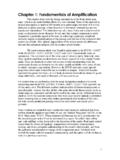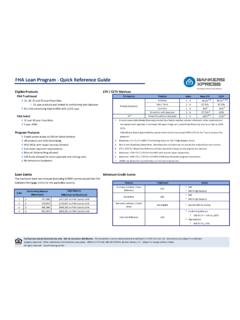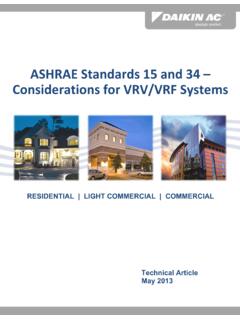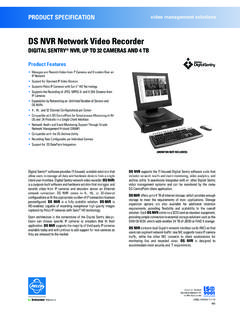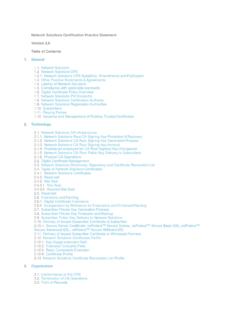Transcription of From Audio Xpress The Optimised SRPP Amp (Part 1)
1 From Audio Xpress , May 2010, The Optimised SRPP Amp ( part 1) By Merlin Blencowe Some deceptively-simple circuits, explained for the Audio amateur. The SRPP is a most enigmatic circuit (fig. 1), and seems to cause bewilderment and inspiration in equal measure, among many valve enthusiasts. It is frequently confused with other, vaguely similar-looking circuits, and its practical uses are not immediately obvious. This article will look briefly at the history of the circuit, its operation, and how it can be Optimised for its task as an output-transformerless power amplifier. Oh, and also a couple of circuits that aren t SRPPs at all!
2 What does SRPP stand for? The first peculiarity of the SRPP is that no one seems to be sure where the name came from! The earliest reference to the circuit (that I could find) is a 1940 patent by Henry Clough of the Marconi company1. Most surprising is that although the patent mainly describes its use as a modulator, it does acknowledge that it could as easily be used as an Audio amplifier. Yet it would be many years before it appeared in a commercial Audio application. In 1943 the SRPP was patented again in slightly different from, by Artzt at RCA2. Still, it does not appear to have been widely used until the advent of television, and was not given a particular name for many years, and is rarely found in radio textbooks of the time (Artzt preferred to call it a series-balanced amplifier 3).
3 Occasionally it does appear under rather generic descriptions like two-tube series useful as a power amplifier 4 or totem-pole amplifier 5. In 1951, Peterson and Sinclair6 finally adapted the SRPP for Audio use, ambitiously calling it a distortionless Audio amplifier in their patent granted in 1957. In this patent they expand it into a -follower 1 Clough, N. H. (1940). Improvement in or relating to Modulator Arrangements. British patent 526418. 2 Artzt, M. (1943). Balanced Direct and Alternating Current Amplifiers. US patent 2310342. 3 Artzt, M. (1945).
4 Survey of DC Amplifiers. Electronics. (August) pp212-8. 4 Valley, G. E. & Wallman, H. (1948). Vacuum Tube Amplifiers, McGraw-Hill Book Company, Inc. 5 Millman, J. & Taub. H (1956). Pulse and Digital Circuits. McGraw-Hill, New York. 6 Peterson, A. P. G. and Sinclair, D. B. (1957). Distortionless Audio Amplifier. US Patent 2802907. and finally produce what they called the single-ended push-pull amplifier7, or SEPP. The SEPP, then, is related, but not identical to, the SRPP as we know it now. By the late 1950s, textbooks on television circuits routinely referred to the SRPP as a shunt regulated amplifier8,9, which at least explains the initials S and R.
5 However, outside the world of television it was generally referred to as a bootstrap amplifier10,11 (which also covered circuits like the -follower and White cathode follower) or SEPP. Of course, we now use the term SEPP for the more specific circuit arrangement by Peterson and Sinclair. From the 1960s onwards a variety of transistor versions appeared 12,13,1415, but still without the name SRPP applied. However, by the 1990s we suddenly find the valve version routinely referred to as the SRPP16,17 (although not always correctly), but exactly who first bestowed these initials remains a mystery (do you know?)
6 Nevertheless, the name of Shunt-Regulated Push-Pull amplifier is now sure to stick, and we at least have some sense of standardisation. Back to basics: If Audio electronics magazines are anything to go by, the operation of the SRPP seems to be routinely misunderstood as something involving a cathode follower. Therefore it might be useful to 7 Peterson, A. P. G. & Sinclair, D. B. (1952). A Single-Ended Push-Pull Audio Amplifier. Proceedings of the IRE (January), 8 Fink, D. G. (ed.) (1957). Television Engineering Handbook. McGraw-Hill, London. Ch13-11.
7 9 Amos, S. W and Birkinshaw, D. C. (1958). Television Engineering, Principles and Practice. 4, 10 Keen, A. W. (1958). Bootstrap Circuit Technique. Electronic and Radio Engineer. (September). Pp. 345-354. 11 Young, J. F. (1962). Bootstrap Amplifier. Wireless World, November, 12 Uti, S., Ueno, Y. & Kashinagi, H. (1967). Push-Pull Amplifier Operated with One Input. US Patent 3328713. 13 Kobayashi, K. (1975). Transistor Amplifying Circuit. US Patent 3890576. 14 Bellamy, & Mueller, G. (1964). Transistor Switching Circuit Responsive in Push-Pull Manner to Single-Ended Input. US Patent 3124758. 15 Butler, F.
8 (1961). The Bootstrap Amplifier (Correspondence). Electronic Technology. (July) p. 267. 16 Touzelet,P. J. (1999). Theory of the SRPP Circuit. Glass Audio . (2) pp. 44-7. 17 Madsen, F. SRPP Power. Sound Practices, (17). Fig. 1: The humble SRPP seems to inspire and confuse in equal measure. Fig. 2: a-c: The common-cathode gain stage and its equivalent circuit. d-f: The common-anode gain stage and its equivalent circuit. (Not a cathode follower in sight!) quickly review the operation of a simple resistance-loaded valve, so as to avoid the same confusion again. Fig. 2a shows a conventional, common-cathode gain stage.
9 The input happens to be supplied from an isolation transformer as this removes any problems with ground-referencing, and the grid is biased negative using a battery. If we input a positive pulse the valve will conduct more anode current. The voltage drop across the anode resistor Ra increases, so the signal voltage at the anode appears inverted. If we draw a Th venin equivalent circuit for this, remembering that ground and the HT are shorted together by the large power supply smoothing capacitors, then we arrive at fig. 2b. We can adjust the diagram again as is c. to show more clearly that, as far as AC signals are concerned, Ra and ra form a potential divider whose gain is Ra/(Ra+ra).
10 If we make vgk equal to 1V then we can express the gain of the whole stage as: aRaARar =+ And the output impedance is: || rRar==+ Where Ra = the anode resistor (plate resistor). ra = the internal anode resistance (plate resistance) of the triode. = the amplification factor of the triode. Now consider the circuit in fig. 2d. At first glance it may look like a cathode follower, and even some experienced builders will mistake it as such. However, the secret lies in the fact that the input signal is still connected directly between grid and cathode, just as it was before, so all we have really moved is the load resistor, which is now called Rk.
